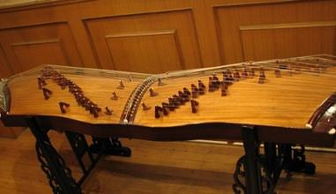The History and Present Situation of Butterfly Zheng
Since the tuning of the zheng has been dominated by the pentatonic scale for more than 2,000 years, in the national orchestra, the difficulty of transposition has become a problem for zheng players when playing ensemble and ensemble works; in addition, with the reform and opening up , the exchanges between Chinese folk music and international music are increasing day by day, and the willingness to integrate with international standards is also increasing. The traditional "Gongshangjiaozhengyu" pentatonic system can no longer meet the needs of music development in the new era. Therefore, under the joint promotion of internal and external factors, various types of guzheng have emerged since the 1960s and 1970s.

Butterfly zheng was born in such a wave of reform.
The butterfly-style zheng got its name because it resembles a butterfly. It was designed and trial-produced by He Baoquan while working at the Tianjin Conservatory of Music in 1965. It was called Xinzheng at that time.
After He Baoquan was transferred to the Shanghai Conservatory of Music in 1976, he further improved and perfected the new zheng. He completed the trial production at the Shanghai Conservatory of Music Musical Instrument Factory and was renamed the butterfly zheng. Butterfly zheng passed the technical appraisal of the Science and Technology Bureau of the Ministry of Culture in 1980.
In 1981, he won the second prize of the National Cultural and Scientific Achievement Award... This award is the highest award for the reform of national instrumental music since the founding of New China in 1949.
In April 1981, the Department of Art Education of the Ministry of Culture issued a notice on the establishment of "Butterfly Zhengzheng Teaching and Classes".
However, due to various reasons, the butterfly-style zheng has not been promoted nationwide as expected.
Compared with the people engaged in traditional zheng performance and teaching, the performers and researchers of the butterfly zither can be described as the tip of the iceberg, and they are all teachers and students in art colleges, and the mass base is extremely weak.
It is gratifying that Professor He Baoquan (the late famous guzheng educator and performer, professor of Shanghai Conservatory of Music) and his wife Associate Professor Sun Wenyan (famous guzheng educator and performer, associate professor of Shanghai Conservatory of Music), the developer of the butterfly zheng, have never stopped the butterfly zither. The improvement and dissemination of the zither, and years of hard work have finally made the butterfly zheng have more and more performers, researchers and communicators in recent years; the Shanghai Conservatory of Music also recruited the first butterfly zheng in 2011. As a professional master student, and taking butterfly zither as a research project, Professor Hua Tianren (an expert in musical instrument building art and music acoustics, professor of Shanghai Conservatory of Music) was appointed as the project leader to conduct special research on it.
 渝公网安备 50010702504639号
渝公网安备 50010702504639号